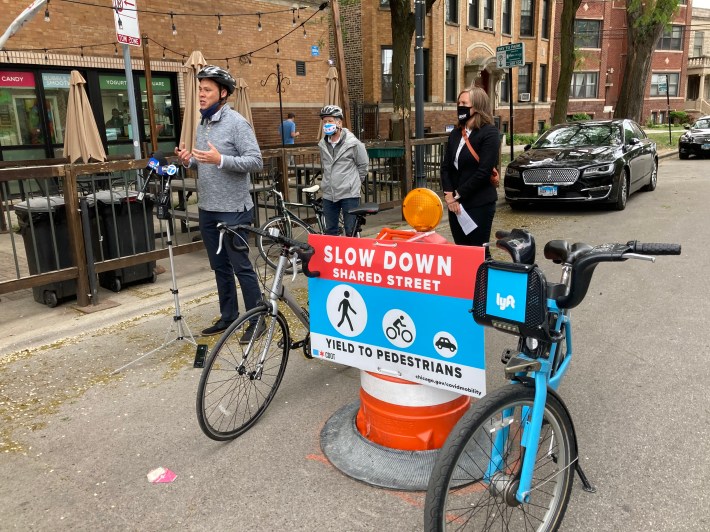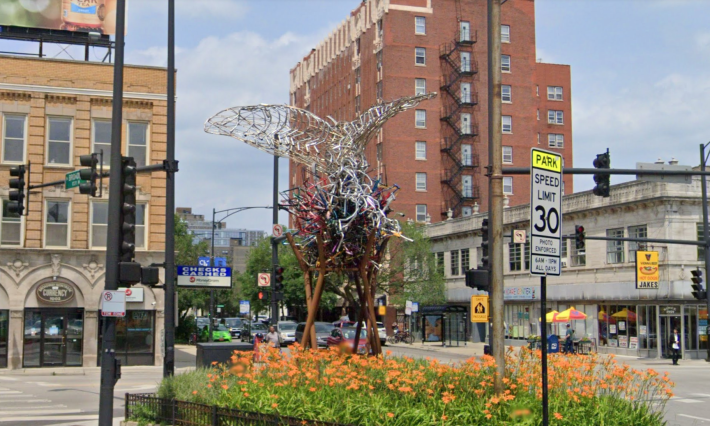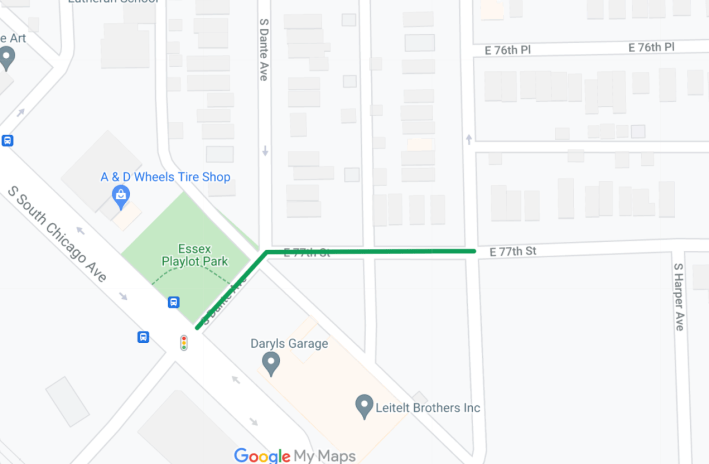A gloomy, wet weather forecast didn't stop folks from turning out for the grand reopening of the Leland Avenue Slow Street (the city calls them "Shared Streets) this afternoon. Leland was the first of a dozen or so such street treatments that debuted last year in the early months of the COVID-19 pandemic, as a strategy to make more room for safe, socially-distanced walking, jogging, scooting, and biking in the street.
The crisis seems to be easing, as more than 60 percent of Illinoisans have received at least one vaccine shot, and new research indicates that outdoor transmission of the coronavirus is extremely rare. But Slow Streets were a smart and often popular intervention to create more people-friendly streets, so they're coming back this year to many neighborhoods.
On Slow Streets, through traffic is banned and local traffic is calmed with barricades and traffic barrels to enable safe biking and pedestrian activity in the street. Although last year the Leland Slow Street ran from the Chicago River to Sheffield Avenue, for starters this year the Slow Street has only been installed east of Lincoln Avenue, where many local residents were enthusiastic about the treatment, according to 47th Ward staff.
"We're really happy to be opening up our [Slow Street] for the second year in a row," said 47th Ward alderman Matt Martin at today's opening celebration. "We knew during the pandemic that people needed more outdoor spaces to be able to congregate and see one another in a safe way as well as exercise. Even with us getting a good handle on the pandemic, what we heard from folks is that they love this as an opportunity to be able to walk, bike, run, be outdoors, use streets in a safe and really really enjoyable way."
Martin said that the Slow Street fits with the ward's broader approach of making the area as friendly as possible to people walking and biking, and families. "So whether it's it's making sure that we have more protected bike lanes, bump-outs for pedestrians, these are some of the things that we're bringing to bear to make our community as inviting as possible."

The alderman noted that, in conjunction with the Slow Street reopening, his office is holding a bike drive to redistribute gently-used cycles to children in the community and across the city who need them. Bikes can be dropped off at the ward office, 4243 N. Lincoln Ave., on weekdays between 9 a.m and 5 p.m.
46th Ward alderman James Cappleman, whose district includes the Leland Slow Street east of Clark Street, noted that about half of his constituents don't have cars, and the ward even has a sculpture at the intersection of Montrose, Sheridan, and Broadway, made of old bike parts. He noted that Leland is a low-stress route that takes cyclists almost all the way to the lakefront. "We're delighted to have [the Slow Street], our residents love it. And I welcome everyone to, please, please, don't get in your car, ride your bike."

Chicago Department of Transportation chief Gia Biagi said last year CDOT installed about 12 miles of Slow Streets across the city. "The traffic is calmed, there's a little extra space, a little extra front yard for residents," she said, emphasizing that the department collected community input on what kind of pandemic street interventions people wanted to see. She noted that yesterday CDOT launched a survey where residents across the city can weigh in on where they’d like to see Slow Streets.
Biagi announced that tomorrow CDOT will be reopening Slow Streets in the 5th Ward, whose alderman is Leslie Hairston, on a few blocks of South Shore Drive between 53rd and 56th streets in Hyde Park; and a short stretch on Dante and 77th Street from South Chicago to Blackstone in Avalon Park and South Shore.

Immediately after the speeches, the rain began. But once the sun comes out, we'll surely see lots of people, including plenty of families and kids, enjoying these safer, traffic calmed streets again.





